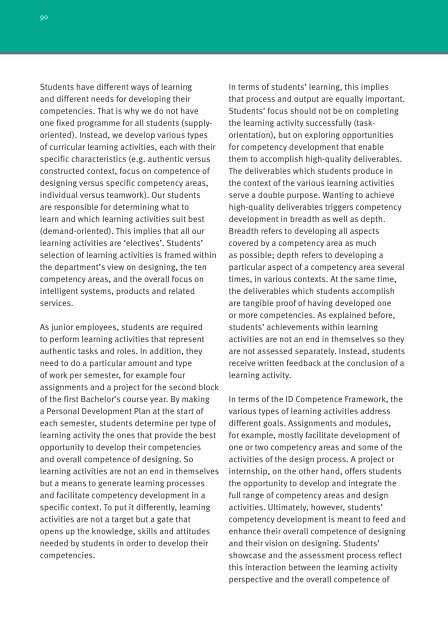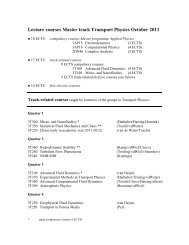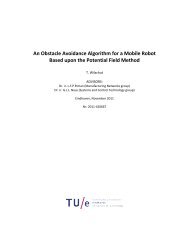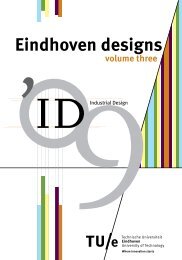Education guide 'Eindhoven designs' - Technische Universiteit ...
Education guide 'Eindhoven designs' - Technische Universiteit ...
Education guide 'Eindhoven designs' - Technische Universiteit ...
You also want an ePaper? Increase the reach of your titles
YUMPU automatically turns print PDFs into web optimized ePapers that Google loves.
90<br />
Students have different ways of learning<br />
and different needs for developing their<br />
competencies. That is why we do not have<br />
one fixed programme for all students (supplyoriented).<br />
Instead, we develop various types<br />
of curricular learning activities, each with their<br />
specific characteristics (e.g. authentic versus<br />
constructed context, focus on competence of<br />
designing versus specific competency areas,<br />
individual versus teamwork). Our students<br />
are responsible for determining what to<br />
learn and which learning activities suit best<br />
(demand-oriented). This implies that all our<br />
learning activities are ‘electives’. Students’<br />
selection of learning activities is framed within<br />
the department’s view on designing, the ten<br />
competency areas, and the overall focus on<br />
intelligent systems, products and related<br />
services.<br />
As junior employees, students are required<br />
to perform learning activities that represent<br />
authentic tasks and roles. In addition, they<br />
need to do a particular amount and type<br />
of work per semester, for example four<br />
assignments and a project for the second block<br />
of the first Bachelor’s course year. By making<br />
a Personal Development Plan at the start of<br />
each semester, students determine per type of<br />
learning activity the ones that provide the best<br />
opportunity to develop their competencies<br />
and overall competence of designing. So<br />
learning activities are not an end in themselves<br />
but a means to generate learning processes<br />
and facilitate competency development in a<br />
specific context. To put it differently, learning<br />
activities are not a target but a gate that<br />
opens up the knowledge, skills and attitudes<br />
needed by students in order to develop their<br />
competencies.<br />
In terms of students’ learning, this implies<br />
that process and output are equally important.<br />
Students’ focus should not be on completing<br />
the learning activity successfully (taskorientation),<br />
but on exploring opportunities<br />
for competency development that enable<br />
them to accomplish high-quality deliverables.<br />
The deliverables which students produce in<br />
the context of the various learning activities<br />
serve a double purpose. Wanting to achieve<br />
high-quality deliverables triggers competency<br />
development in breadth as well as depth.<br />
Breadth refers to developing all aspects<br />
covered by a competency area as much<br />
as possible; depth refers to developing a<br />
particular aspect of a competency area several<br />
times, in various contexts. At the same time,<br />
the deliverables which students accomplish<br />
are tangible proof of having developed one<br />
or more competencies. As explained before,<br />
students’ achievements within learning<br />
activities are not an end in themselves so they<br />
are not assessed separately. Instead, students<br />
receive written feedback at the conclusion of a<br />
learning activity.<br />
In terms of the ID Competence Framework, the<br />
various types of learning activities address<br />
different goals. Assignments and modules,<br />
for example, mostly facilitate development of<br />
one or two competency areas and some of the<br />
activities of the design process. A project or<br />
internship, on the other hand, offers students<br />
the opportunity to develop and integrate the<br />
full range of competency areas and design<br />
activities. Ultimately, however, students’<br />
competency development is meant to feed and<br />
enhance their overall competence of designing<br />
and their vision on designing. Students’<br />
showcase and the assessment process reflect<br />
this interaction between the learning activity<br />
perspective and the overall competence of

















